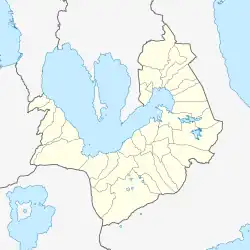| Nuestra Señora dela Natividad Parish (Pangil Church) | |
|---|---|
| |
 Pangil Church from the town plaza in 2013 | |
 Nuestra Señora dela Natividad Parish (Pangil Church) .svg.png.webp) Nuestra Señora dela Natividad Parish (Pangil Church) .svg.png.webp) Nuestra Señora dela Natividad Parish (Pangil Church) | |
| 14°24′13″N 121°28′06″E / 14.403492°N 121.468465°E | |
| Location | Pangil, Laguna |
| Country | Philippines |
| Denomination | Roman Catholic |
| History | |
| Status | Parish church |
| Founded | 1579 |
| Founder(s) | Juan de Plasencia and Diego Oropesa |
| Dedication | Nativity of the Blessed Virgin Mary |
| Architecture | |
| Functional status | Active |
| Architectural type | Church building |
| Style | Baroque |
| Completed | 1611 |
| Administration | |
| Archdiocese | Manila |
| Diocese | San Pablo |
| Clergy | |
| Priest(s) | Jessie Somosierra |
The Nuestra Señora dela Natividad Parish, commonly known as Pangil Church, is a Roman Catholic church in Natividad, Pangil, Laguna, Philippines. The statue of the pregnant Virgin Mary (locally known as Nuestra Señora de la O) is said to be a gift from King Carlos III of Spain.[1]
History

Pangil was founded as a visita or hermitage by Franciscan friars Juan de Plasencia and Diego de Oropesa in 1579. It was administered by the nearby parish of Lumban due to lack of priests.[2] The first church dedicated to the Nativity of the Blessed Virgin Mary was built out of cane. In 1611, a stone church and convent was built under the direction of Father Gonzalo del Roble. Restoration of the church's woodwork and improvement of the convent was done by Father Lucas Fernandez in 1711. The church was remodeled in 1749 to 1751 by Father Luis de Nambroca. Based on the records of Father Felix Huerta, the church has also a stone chapel dedicated to Saint Mark the Evangelist and Saint Anthony Abad.[3]
Notes
- ↑ Giron, Tita (20 March 2005). "A scenic way to do the traditional 'Via Crucis'". Vol. 19, no. 102. Philippine Daily Inquirer. pp. E1–E2. Retrieved 9 May 2020.
- ↑ Huerta 1865, pp. 132–133
- ↑ Huerta 1865, p. 133
Bibliography
- Huerta, Felix de (1865). Estado geográfico, topográfico, estadístico, histórico-religioso [Geographical, topographical, statistical, historical and religious state] (in Spanish). Binondo: Imprenta de M. Sanchez y Ca.
External links
 Media related to Our Lady's Nativity Parish (Pangil) at Wikimedia Commons
Media related to Our Lady's Nativity Parish (Pangil) at Wikimedia Commons- Facebook page of Our Lady's Nativity Parish
